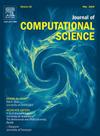Evaluation of new CORDIC algorithms implemented on FPGA for the Givens Rotator
IF 3.7
3区 计算机科学
Q2 COMPUTER SCIENCE, INTERDISCIPLINARY APPLICATIONS
引用次数: 0
Abstract
This article is an extended version of our conference paper ”Modified CORDIC Algorithm for Givens Rotator” (Poczekajlo et al., 2024) published at the International Conference on Computational Science (ICCS-2024). The CORDIC algorithm is an iterative method of computing trigonometric functions and rotating vectors without using complex calculations. This paper presents two modified CORDIC algorithms for implementing a Givens rotator on FPGA, improving upon classic CORDIC methods. The first approach introduces a selective iteration scheme with an optimized scaling factor, while the second, not published in the original ICCS-2024 paper, leverages a scaling-free methodology for improved precision. Implemented on an Altera Cyclone V FPGA, these algorithms demonstrate a 50% accuracy improvement and a 15% reduction in latency compared to standard methods. These findings contribute to enhanced FPGA-based trigonometric computations, particularly benefiting real-time signal processing and numerical linear algebra applications.
基于给定旋转器的新CORDIC算法在FPGA上实现的评估
本文是我们在国际计算科学会议(ICCS-2024)上发表的会议论文“Modified CORDIC Algorithm for Givens Rotator”(Poczekajlo et al., 2024)的扩展版本。CORDIC算法是一种计算三角函数和旋转矢量的迭代方法,不需要复杂的计算。在经典的CORDIC算法的基础上,提出了在FPGA上实现给定旋转器的两种改进的CORDIC算法。第一种方法引入了具有优化比例因子的选择性迭代方案,而第二种方法(未在原始ICCS-2024论文中发表)利用无比例方法来提高精度。这些算法在Altera Cyclone V FPGA上实现,与标准方法相比,精度提高了50%,延迟降低了15%。这些发现有助于增强基于fpga的三角计算,特别是有利于实时信号处理和数值线性代数应用。
本文章由计算机程序翻译,如有差异,请以英文原文为准。
求助全文
约1分钟内获得全文
求助全文
来源期刊

Journal of Computational Science
COMPUTER SCIENCE, INTERDISCIPLINARY APPLICATIONS-COMPUTER SCIENCE, THEORY & METHODS
CiteScore
5.50
自引率
3.00%
发文量
227
审稿时长
41 days
期刊介绍:
Computational Science is a rapidly growing multi- and interdisciplinary field that uses advanced computing and data analysis to understand and solve complex problems. It has reached a level of predictive capability that now firmly complements the traditional pillars of experimentation and theory.
The recent advances in experimental techniques such as detectors, on-line sensor networks and high-resolution imaging techniques, have opened up new windows into physical and biological processes at many levels of detail. The resulting data explosion allows for detailed data driven modeling and simulation.
This new discipline in science combines computational thinking, modern computational methods, devices and collateral technologies to address problems far beyond the scope of traditional numerical methods.
Computational science typically unifies three distinct elements:
• Modeling, Algorithms and Simulations (e.g. numerical and non-numerical, discrete and continuous);
• Software developed to solve science (e.g., biological, physical, and social), engineering, medicine, and humanities problems;
• Computer and information science that develops and optimizes the advanced system hardware, software, networking, and data management components (e.g. problem solving environments).
 求助内容:
求助内容: 应助结果提醒方式:
应助结果提醒方式:


